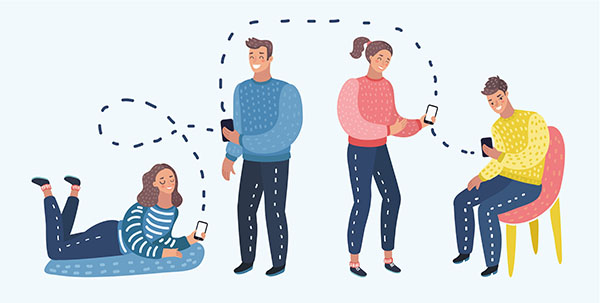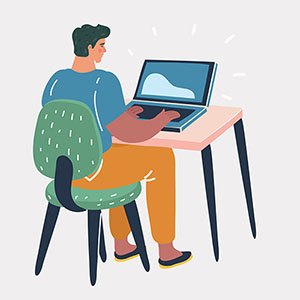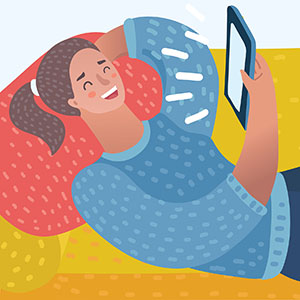
Do you suffer from dry or itchy eyes? Do you work in front of a computer or own a smartphone? Thousands of millennials in Santa Monica and throughout Los Angeles work in tech environments that require extended screen use, and our beloved technology is contributing to the dry eye problem.
Whether you realize it or not, dry eye can be a serious issue. Is this something that can be fixed?
What is dry eye?
Dry eye, also known as dry eye disease, is a condition that causes eye irritation, dryness, and sometimes even excessive tearing. Dry eye can be caused by a variety of factors and is experienced by millions of Americans every year.
Dry eye occurs when you don’t have enough quality tears, or quantity of tears, in your eyes. When this happens, the eye cannot be properly lubricated and irritation occurs.
A healthy tear film is made up of three layers: an aqueous layer (water), a mucous layer (mucus), and a lipid layer (oil). All three of these components are necessary to keep your eyes healthy. If the tear film is missing or lacking in any of these three crucial layers, you are likely to end up with dry eye symptoms.
What kind of dry eye do you have?
There isn’t only one kind of dry eye – there are two! The most common kind of dry eye is evaporative, which affects 65% of people with dry eye. The second type of dry eye is called Aqueous tear-deficient dry eye.
When a patient has evaporative dry eye, it is caused by meibomian gland dysfunction (MGD). The meibomian glands of the eye are located in the eyelids and are responsible for secreting the oils that form the lipid layer of tears. When these glands are unable to secrete oils into the tear mixture due to blockage, or when the oils are too thick to pass appropriately through the glands, meibomian gland dysfunction occurs.
Common symptoms of evaporative dry eye include:
- a foreign body sensation
- not being able to wear contacts
- light sensitivity
- blurred vision
- red or swollen eyes and eyelids
The second and less prevalent kind of dry eye is aqueous dry eye. Aqueous tear-deficient dry eye occurs when meibomian glands don’t produce enough tears. This is different from evaporative dry eye because it is associated with the number of tears produced rather than the quality. This has nothing to do with oil deficiency in the tear film.
Many patients with aqueous dry eye have a condition known as Sjogren’s syndrome. This condition affects the glands that make spit and tears, causing dry eye and dry mouth. Aqueous dry eye is also associated with old age, because tear glands don’t work as well as the body ages.
Common symptoms associated with aqueous dry eye are:
- blurry vision
- tired eyes after reading
- itching, burning, or painful eyes
Increased screen time is bad for your eyes
A typical workday in today’s tech-heavy world can involve waking up to smartphone use, prolonged time spent in front of a monitor (or several!) throughout the day, and further screen time using computers, televisions, and smartphones at night. Our eyes hardly get a break from screens! If you are like many Americans, you’re in front of some kind of screen almost constantly.
It’s days like this that explain why so many millennials have dry eye. Is it any surprise to learn that millennials are spending an average of 8 hours per day on their smartphones? With screens everywhere, dry eyes become a big problem. The blue light coming off of smartphones and other devices can cause harm to the retina and other parts of the eye.

Excessive blue light exposure can also lead to dry eye. Then, there’s the whole other issue of all this screen time leading to less blinking. This might not sound like a big deal, but it is! On average, we should blink 15-20 times every minute. When you’re looking at computer screens or your iPhone all day, that blink rate decreases, meaning your eyes are open longer before blinking.
This is why your eyes may feel gritty or sore when they’ve been open for too long. The more time you spend not blinking, the drier your eyes can get. For many young professionals, it’s a vicious, never-ending cycle. Looking at screens all day means more Digital Eye Strain (DES) and dry eye disease diagnoses.
Fixing the dry eye problem
Dry eye is a problem, but there’s no one size fits all solution. There are various things you can try at home to reduce your dry eye symptoms like:
- artificial tears
- warm compresses
- drinking more water
- taking Omega 3 supplements
- avoiding direct heat sources
- investing in a humidifier
For some people, these things may help. But if you have dry eye disease, you may need medical treatment. A thorough dry eye evaluation with an ophthalmologist like Dr. Hamilton can help to diagnose the cause and type of dry eye, helping patients to find a solution that will work for them.
One of the best dry eye treatments available is LipiFlow, a revolutionary new option for patients with dry eye disease. The LipiFlow device heats and massages the eyelids, targeting the meibomian glands. By warming and massaging the eyelids, blockages in the oil glands of the eye are removed, enhancing tear quality and reducing the symptoms of dry eye.
Dr. Rex Hamilton in Los Angeles was one of the first physicians on the West Coast to offer LipiFlow to treat dry eye disease!
Other popular treatment options for dry eye include:
- punctal plugs, either temporary or permanent
- prescription artificial tears like Regenereyes
- medications to reduce eyelid and cornea inflammation such as antibiotics and Restasis
Vision correction options if you have dry eye: LASIK & SMILE
Right now, glasses are hip and having a moment, and contacts are always an option if glasses don’t suit your style or you find them uncomfortable. But, what if there was a way to see clearly all the time, without resorting on glasses or contacts? Would you do it?
If you wear contacts and have dry eye, they could be contributing to your dry eye symptoms! Wearing contacts and staring at screens all day tire out your eyes, making them sore, dry, and bloodshot. We wouldn’t blame you if you were ready for freedom from contacts or glasses! For patients whose dry eye is related to contact lens wear, there are several vision correction options available.

If you have dry eye, you may have fewer options than patients without dry eye for vision correction procedures. You could consider LASIK, which creates a flap in the cornea with two lasers. This flap reshapes the cornea and corrects refractive errors. Patients who have had LASIK will often experience some transient increase in dry eye symptoms for several months following the procedure.
Another vision correction procedure to consider is SMILE laser eye surgery. SMILE laser uses a smaller incision than LASIK to reshape the cornea, resulting in less disturbance to the surface of the eye. Unlike LASIK, SMILE laser uses only one laser to create a 2-3 millimeter incision.
After the incision, a lenticule the size of a small contact lens is then created and pulled through the tiny opening in the cornea. There’s never any flap creation, so more nerve bundles in the top layer of the cornea are left undisturbed.
For SMILE laser patients, this means a shorter recovery period and less risk of developing dry eye! And what about patients with dry eye that get SMILE laser? They often report that their dry eye symptoms improve after healing from SMILE laser!
Dry eye is nothing to mess around with. If you’re ready to enjoy the world again without dry eye symptoms, it’s time to find out what your options are.
Schedule a consultation with Dr. Rex Hamilton today in Los Angeles, CA to evaluate and treat your dry eye and see if you are a candidate to get rid of your glasses and contact lenses!

